
- The 26 km Dawes Range section offers offers stunning mountain views as it passes through six tunnels in towards the top, with an array of National Parks nearby
- The 32km Mt Debateable to Mundubbera section follows the Burnett River for most of the way, has great views of some beautiful heritage bridges, with opportunities for canoeing
- The 7km section from Mt Debateable to Reids Creek is open.
- The 6km Four Mile Scrub to Boynedale Bush Camp section is along the shores of Lake Awoonga.
- The corridor from Targoola to Gayndah is 270km long, so potentially could be Australia’s longest rail trail
- Camping available along the rail trail.
Nearby Attractions
- Abundant birdlife, wildlife and views
- Good climate most of the year
- Heritage Railway bridges
- Heritage Railway Station Precincts at Gayndah, Mundubbera and Monto
- Mt Gayndah – McConnell Lookout near Gayndah, offers stunning panoramic views
- Burnett River (Gayndah to Mundubbera section)
- Camping and accommodation options in towns along the trail and at Kalpowar State Forest
- Glassford Creek Copper Mine, Kroombit Tops, Bulburin National Park
- Gayndah (Queensland’s oldest inland town) and Mundubbera are the state’s citrus capitals
- Gayndah has the Big Orange, and the Orange Festival on May long weekend every odd year
- Mundubbera has the Big Mandarin, and the Blueberry Festival every odd year
- Dawes Range section is close to Monal goldfields
- Reginald Murray Williams Australian Bush Learning Centre and Visitor Information Centre at Eidsvold
- The Boynedale Bush Camp
Last updated: 20 January 2024
The rail trail is being developed in stages with three sections open:
1. Dawes Range (or Tunnels) section 26km
2. Reids Creek to Mundubbera (or Bridges) section 39km
3. Four Mile Creek to Boyndale 6km
- Parking at rail sidings
- Water and toilets available in most small towns along the corridor, refer details below
Section Guides
Dawes Range – Barrimoon Siding to Builyan (26 km)
- Firm gravel surface to tunnels, softer gravel and sand in some sections after that, suitable for mountain bikes.
- Cattle on corridor
- No mobile phone service: UHF can be used in the area
- Carry plenty of water
- Most bridges are intact, but are not trafficable at this stage, so waterways may be impassable after rain.
Barrimoon Siding is about 6km from Kalpower. Currently there are temporary corflute rail trail signs placed at strategic positions from Monto to the high point over the ranges at Barimoon Siding. (Note it is a gravel road from Kalpowar down to Builyan)
The first ten kilometres of the trail descends via sweeping curves through the six tunnels and many impressive cuttings, delivering panoramic views of the countryside.
Once descended into the valley, the trail surface becomes less firm with some soft and sandy sections, gates to be opened and steep and loose gullies to be negotiated under existing rail bridges. The gullies are manageable when dry but will likely be impassable if water flows during or after rainfall events. All but one gates are straightforward to manage.
Approaching Many Peaks there is a signed loop detour to get trail users around the disused railway bridge. The signage is a little vague. There is brand new toilet amenity block at the historic Many Peaks Railway Dam but that is not on the rail trail. You need to get on to the (very low traffic) bitumen road at Many Peaks and ride back less than a kilometre to the new park. It is well worth doing so as there is a new shelter shed, history information signage, toilet block and elevated lookout over the old weir. There is no drinking water available.
The final section to Builyan Siding has more soft sections.
Facilities
- Kalpowar is a very small village with limited accommodation and facilities, and is 6km from Barrimoon Siding
- 2km From Barrimoon Siding is the Kalpowar State Forest camping area with a toilet.
- Many Peaks has the toilet block at Railway Dam and the hotel (not open)
- Builyan is small village with limited facilities; a general store (not always open), and showers and toilets at Builyan Community Hall.
- The nearest major regional centre is Monto, so bring all required food and drink.
For those wanting more detail, the six tunnels were built just after World War I and their lengths are: No.1 – 100m, No.s 2 and 3 – 105m, No. 4 – 130m, No. 5 – 155m and No. 6 – 170m. Tunnel 6 still has the rail line and the original ‘hogback’ sleepers in place. One tunnel is significantly curved so that it is dark upon entering but after a short distance light starts to appear from the other end, so torches are not essential but may be helpful.
Mt Debateable to Mundubbera (32 km)
The trail does not actually start at Gayndah, because of a missing bridge across Reids Creek. The access point is at the Mt Debateable station site, which can be accessed by using the old Gayndah – Mundubbera Road and turning right onto the Mt Debateable Road approx 10km west of Gayndah.
Mostly only suitable for fit mountain bikers, walking and horse riding. Cyclists should be well prepared with provisions for puncture repair. Expect significant soft sandy sections which will slow progress and some difficult gully crossings. There are plenty of gates especially towards Mundubberra.
- The trail surface varies from hard packed ballast, to loose sand and soft mud
- Includes a remarkable number of heritage listed bridges. However none of the bridges are open at present, and temporary bypasses (some steep and rough) have been built around them.
- Close to the Burnett River providing stunning views and koalas have been sighted in the eucalypt forest beside the trail.
- No toilets or drinking water along the trail
- Cattle on the corridor
This section was opened by the volunteer committee in Sept 2022 at low cost to provide access for those keen to experience this picturesque section while funding is obtained to deck the many bridges and improve the trail surface.
Camping is available at Gayndah Railway Station and Mundubbera Show grounds.
Mt Debateable to Reids Creek (7km)
Mostly only suitable for fit mountain bikers, walking and horse riding. Cyclists should be well prepared with provisions for puncture repair. Expect significant soft sandy sections which will slow progress and some difficult gully crossings.
Follows the Burnett River towards Gayndah, and ends at Reid’s Creek where a large bridge was destroyed by floodwaters in 2013. Funding is being sought to build a bridge across the creek again to connect the trail into Gayndah.
Four Mile Scrub to Boynedale Bush Camp (6km)
This walking only section runs from Four Mile Scrub to the popular Boynedale Bush Camp, along the shores of Lake Awoonga.
It has a smooth gravel surface and is basically flat.
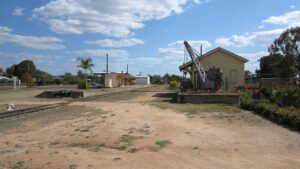
Gayndah station (2018)
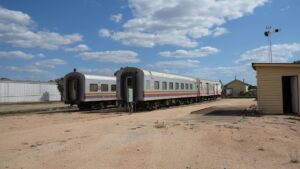
The Gayndah Rail Trail group has plans to make these former carriages part of the rail trail experience. (2018)
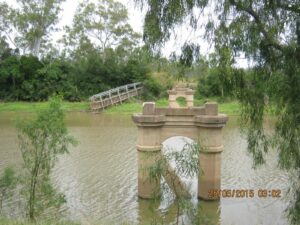
Unfortunately, Reid Creek bridge 5km west of Gayndah was severely damaged in 2013, splitting the first section. (Mike Goebel)
![Riding from Mt Debateable back to Reid's Creek [2022]](https://www.railtrails.org.au/wp-content/uploads/2022/09/Q40-227-On-the-trail-between-Mt-Debateable-and-Reids-Creek-2022-09-300x225.jpg)
Riding from Mt Debateable back to Reid's Creek [2022]
![The rail trail between Mt Debateable and Humphery besides the Burnett River [2023]](https://www.railtrails.org.au/wp-content/uploads/2023/03/Q40-225-Burnett-River-Mt-Debateable-to-Humphery-20230310_090556-300x169.jpg)
The rail trail between Mt Debateable and Humphery besides the Burnett River [2023]
![The scenery between Mt Debateable and Humphery on the way to Mundubbera [2022]](https://www.railtrails.org.au/wp-content/uploads/2022/11/Q40-227-20220222_Nice-part-of-the-trail-between-Mt-Debateable-and-Humphery-2_crop0-300x170.jpg)
The scenery between Mt Debateable and Humphery on the way to Mundubbera [2022]
![Humphery No. 2 bridge, one of the many significant bridges between Gayndah and Mundubbera [Thom Hansen 2020]](https://www.railtrails.org.au/wp-content/uploads/2023/03/Q40-256-Humphery-No-2-Bridge-Faith-aerial-2020-06-300x225.jpg)
Humphery No. 2 bridge, one of the many significant bridges between Gayndah and Mundubbera [Thom Hansen 2020]
![The impressive Humphery No. 2 bridge is open for a great view of the river, but steep gradients either side due to bridges either side not yet being decked [2023]](https://www.railtrails.org.au/wp-content/uploads/2023/03/Q40-256-Humphery-No-2-bridge-20230310_100039-300x169.jpg)
The impressive Humphery No. 2 bridge is open for a great view of the river, but steep gradients either side due to bridges either side not yet being decked [2023]
![Funding to deck the many bridges between Mt Debatable at Mundubbera is still being sort so at the moment steep low level crossings are required around all bridges [2022]](https://www.railtrails.org.au/wp-content/uploads/2022/09/Q40-258-P1080582-Boomerang-Bridge-2022-09-300x225.jpg)
Funding to deck the many bridges between Mt Debatable at Mundubbera is still being sort so at the moment steep low level crossings are required around all bridges [2022]
![Slab Creek bridge is another significant bridge between Gayndah and Mundubbera. Funding is being sought for decking. [2019]](https://www.railtrails.org.au/wp-content/uploads/2023/03/Q40-256-Slab-Creek-bridge-2019-09-17_095752-300x169.jpg)
Slab Creek bridge is another significant bridge between Gayndah and Mundubbera. Funding is being sought for decking. [2019]
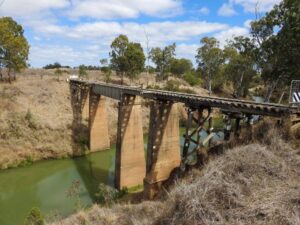
Until Philpott Creek bridge is decked, unfortunately a four kilometre diversion on back roads is necessary.

Mundubbera station station still retains rails and numerous buildings. (Mike Goebel 2015)
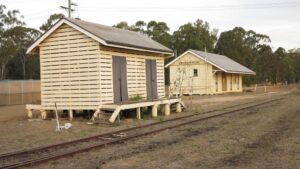
The station and a length of track remain at Eidsvold (2018)

Monto station, which is being used for short stays by caravans and RVs (2018)

Monto has many of the charms of a Queensland regional centre. (2018)

Typical scenery between Monto and Kalpowar (2018)
![Inside Tunnel No. 6 (at the top) where the rail trail group has retained some track and unique sleepers [2022]](https://www.railtrails.org.au/wp-content/uploads/2021/11/Q20-506-Tunnel-6-2021-225x300.jpg)
Inside Tunnel No. 6 (at the top) where the rail trail group has retained some track and unique sleepers [2022]
![View from near the top of the Dawes Range, between tunnels [Gladstone Region Tours 2022]](https://www.railtrails.org.au/wp-content/uploads/2022/11/Q40-508-Tunnel-4-to-3-Dawes-Range-lookout-2022-10-300x169.jpg)
View from near the top of the Dawes Range, between tunnels [Gladstone Region Tours 2022]
![Tunnel No. 3 in the Dawes Range [2021]](https://www.railtrails.org.au/wp-content/uploads/2021/11/Q20-506-Tunnel-3-2021-300x220.jpg)
Tunnel No. 3 in the Dawes Range [2021]
![Having a break while climbing the Dawes Range to admire the massive embankments and cuttings, all done by manual labour [2023]](https://www.railtrails.org.au/wp-content/uploads/2023/03/Q40-507-Tunnels-to-Golembil-2023-03-09_163452-300x169.jpg)
Having a break while climbing the Dawes Range to admire the massive embankments and cuttings, all done by manual labour [2023]
![A gully of marvellous grass trees at the start of the climb up the Dawes Range [2023]](https://www.railtrails.org.au/wp-content/uploads/2023/03/Q40-507-grass-tree-gully-2023-03-09_162847-300x169.jpg)
A gully of marvellous grass trees at the start of the climb up the Dawes Range [2023]
![Glassford Ck bridge at Golembil at the bottom of the range. There is currently a low level diversion around it. [2021]](https://www.railtrails.org.au/wp-content/uploads/2021/11/Q20-556-Glassford-Ck-bridge-Golembil-2021-300x169.jpg)
Glassford Ck bridge at Golembil at the bottom of the range. There is currently a low level diversion around it. [2021]

After descending the range, typical scenery to Many Peaks and Builyan. There is currently a low level diversion around all bridges including the Coppermine Creek bridge. (2018)

A little bit of civilisation again at Many Peaks (2018)

Typical scenery between Builyan and Boynedale (2018)

At Boynedale the rail line skirts Lake Awoonga, as it had to be relocated in the 1990s when the lake level was raised (2018)

Lake Awoonga, as it had to be relocated in the 1990s when the lake level was raised (2018)
![Looking back up the Boyne Valley towards Lake Awoonga [2018]](https://www.railtrails.org.au/wp-content/uploads/2021/11/Q20-705-Boynedale-to-Taragoola-2018-09-0265-300x169.jpg)
Looking back up the Boyne Valley towards Lake Awoonga [2018]
A shuttle service is available on the tunnels section of this rail trail. Packs and Pedals is a small company based at Monto, and offers limited shuttles and tours.
Do you know of a bike hire or transportation service on this rail trail that should appear here? If so, let us know at admin@railtrails.org.au.
Information and Links
For further information about the condition and maintenance of the rail trail, please contact the following:
- Burnett River Bridges section (Gayndah to Mundubbera): Mike Goebel on 0439 768 341 or email mikegoebel54@gmail.com
- Dawes Range section (Barrimoon to Builyan): Mark McLachlan on 07 4974 1207 or email mclachlan.mark@gmail.com
Some useful links:
Boyne Burnet Inland Rail Trail
Boyne Burnet Inland Rail Trail Facebook page
Parks of Boyne Valley and surrounds map
RM Williams Australian Bush Learning Centre and Visitor Information
Contact Rail Trails Australia
To contact us about this rail trail, email qld@railtrails.org.au
Background Information
Traditional Owners
We acknowledge the Wuli Wuli and Gureng Gureng people, the traditional custodians of the land and waterways on which the rail trail is situated.
Rail Trail Development
After Queensland Rail confirmed the line from Gayndah to Taragoola would be closed, in 2012 several community groups from towns along the rail line from Gladstone to Maryborough held discussions with the Queensland Government about the future of the corridor, which closed in 2002. Each district had its own aims and ambitions, ranging from preserve the tracks as a working railway to developing the corridor as a recreational trail to showcase the old infrastructure while creating a rail trail to attract a range of tourists to the towns and districts along the path of the old corridor.
In 2019 a feasibility report was released recommending construction of three sections of rail trail;
- 36km along Lake Awoonga
- 32km Dawes Range from Builyan to Kalpowar
- 29km Burnett River Bridges from near Gayndah to Mundubbera.
The Boyne Burnett Inland Rail Trail organisation quickly swung into action and opened the 26 km Dawes Range section from Builyan to Barrimoon Siding in September 2021 with a minimum level of development to get usage going. They would like to extend this another 6km to Kalpowar.
The Burnett River Bridges section opened in 2022, with diversions around the bridges at this stage.
The Boynedale section was opened in 2023 by the Gladstone Area Water Board.
Railway history
Queensland Railways constructed an inland railway loop from Mungar (south of Maryborough) to near Gladstone via Monto — a total of 406 km. The first section from Mungar opened in 1889 and the last section to join Monto from Gladstone opened in 1931.
A feature of the line is the varied construction styles and architecture of the bridges, particularly in the Gayndah region.
The last regular train ran in 2002 and the last train was a steam special in 2008.
The 125 km Mungar to Gayndah track is still in place for possible future use.
Boyne Burnett Inland Rail Trail Weekend
Posted: 20/01/24
A great weekend is being offered early in May --- spend the weekend on the ...
More...Another step closer to becoming Australia’s longest rail trail for Boyne Burnett Inland Rail Trail
Posted: 08/10/23
Construction of Australia’s soon to be longest rail trail has recently gained momentum, with ...
More...Celebrations for opening of Four Mile Scrub to Boynedale Bush Camp Rail Trail
Posted: 30/06/23
Gladstone Area Water Board (GAWB) celebrated the opening of its new $970,000 Four Mile Scrub to ...
More...Burnett River Bridges Rail Trail Open
Posted: 28/09/22
Under sunny skies the Burnett River Bridges section of the Boyne Burnett Inland Rail Trail (...
More...Opening of the Burnett River Bridges section of the Boyne Burnett Inland Rail Trail
Posted: 10/07/22
The Boyne Burnett Inland Rail Trail committee invites you to the opening of the Burnett ...
More...Boyne Burnett Rail Trail – Opening the Dawes Range Section
Posted: 03/10/21
The opening of the Dawes Range section of the Boyne Burnett Inland Rail Trail in ...
More...Boyne Burnett Inland Rail Trail Report Released
Posted: 23/05/19
The Boyne Burnett Inland Rail Trail would provide a link between Taragoola, near Gladstone, south ...
More...Nearby Trails

Boolboonda Tunnel Heritage Trail
Approximately 90km west of Bundaberg, 400km from Brisbane
3 km



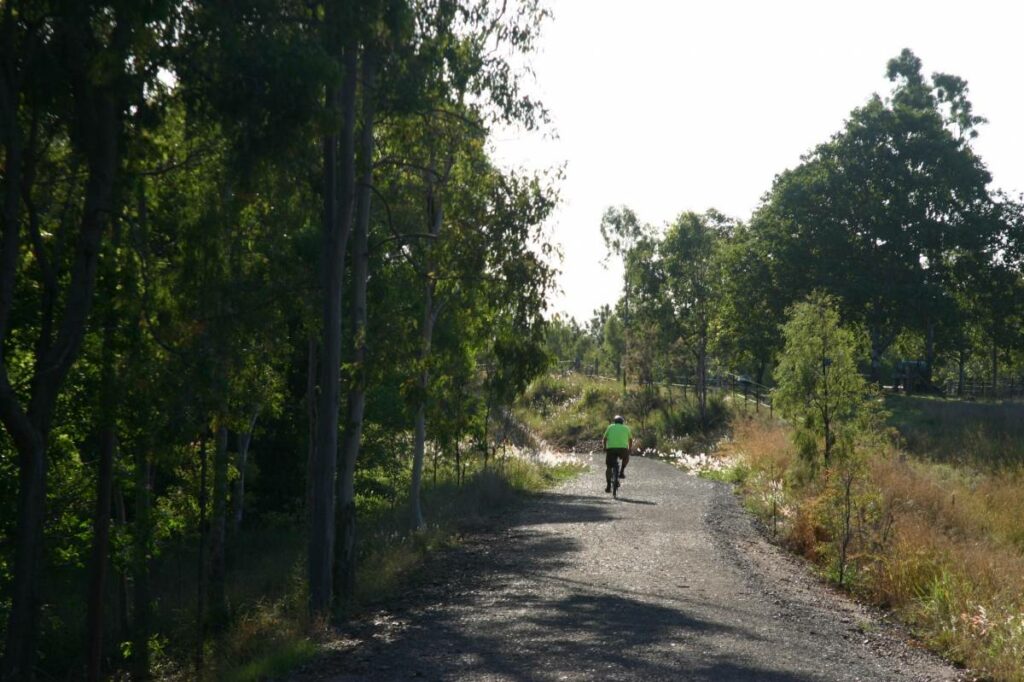
Bundaberg to Gin Gin (Watawa) Rail Trail
Gin Gin Township - approximately 50 km west of Bundaberg, 365km from Brisbane
3.4 km





 We operate a shuttle and luggage transfer service along the Boyne Burnett Inland Rail Trail.
We operate a shuttle and luggage transfer service along the Boyne Burnett Inland Rail Trail.
10 reviews of “Boyne Burnett Inland Rail Trail”
Bridges Section: Philpott Bridge to Humphrey Siding
This section has seven railway bridges including the Humphrey No. 2 bridge, which is the most interesting bridge as it is a concrete arch viaduct bridge that is still serviceable with passage over the top. The other bridges are all interesting variations of timber, concrete pier and steel trestle. The gullies around these bridges are easier to negotiate than the Philpott bridge gully but are still challenging to less confident off road riders. There is a display in the railway station at Mundubberra that provides information about each of the bridges although I found the sequence of bridges to be different to what was indicated in the information display. Difficult to know for sure as none of the bridges have names on them when you get to one.
Generally, the trail is reasonably okay to cycle but the stones are flinty and sharp. We had two punctures within our group of four riders. A local farmer happened upon us as we were repairing one flat and he said the last pair of cyclists he spoke to also had issues with punctures. Be prepared for flats! From Boomerang Siding to Humphrey Siding there is a well formed gravel road running parallel to the trail and close by the Burdekin River. It is much easier to ride than the rail trail and provides better views of the river. We chose to ride the trail one way then return by the gravel road. This is a scenic ride but not an easy ride.
Bridges Section: Philpott Bridge to Mundubbera.
This section should only be attempted by competent off road cyclists with mountain bikes, preferable full suspension.
This has very scenic sections near the Burnett River and more open pastoral country heading into Mundubbera. The gully crossing under the bridge is challenging being both steep and rough. After rain it would be impassable. The trail itself is a hard slog with many sections of rocky ballast and soft, coarse sand and rock. Some sections have a rough trail off to one side as the formation itself is just too soft. I punctured after my near new MTB rear tyre developed a 5mm slit in the carcass of the tyre and the tube became exposed. I averaged 10km/hr (moving time) over this section. (I am an experienced mountain biker/ adventure touring cyclist with a full suspension ebike.) There is a diversion on what appears to be a four wheel drive stock route around one closed section of the corridor which has a bolted shut gate.This is not apparent until you proceed along the corridor some distance. The diversion has multiple gates to negotiate but they are all new gates, easy to open and close. There are signs but best to use the RTA map to guide you around.
The Mundubbera Railway Station is now a small historical museum with loads of information. There is a good bakery cafe in the town for coffee and food. This is definitely an adventure trail.
We asked locals including the tourist information centre for information about the trail. No help. Eventually we found the details on this page. Even then, as we’re not locals, it took some time to find the trail head.
At the trail head you can go east to the 7 klm section to reids or west to mundubbera. Loved the humor of the sign writer at trail head. . Overall a good track that in time will attract a LOT of bike, walking and horse traffic. The volunteers have done a wonderful job. Some signage was challenging. We chose to ride about 10klms towards Mundubbera from trail head and return. Lots to see and the range of bridges is neat. Top effort to all volunteers. If promoted to Brisbane Valley Rail Trail pages, it would attract those wanting the challenges that the current trail offers.
This was the first of the rail trails that my wife and I have attempted and it certainly won’t be our last. We left home in Bundaberg at lunchtime, arriving at Kalpowar State Forest campground by mid afternoon. The weather wasn’t the best, overcast with some fine rain around, but we decided to get the bikes off the rack and hit the trail just to have a look, as our plan was to complete the whole trail, there and back, the following day. We ride full suspension Electric mountain bikes, and although the signs were quite clear, we did actually miss the entrance to the trail, mistaking the gateway for a private property. We ended up on very steep muddy roads which were really quite challenging even on an ebike, eventually turning round and going back to camp. I have a BLUETTI battery bank in the campervan, so was able to clean the bikes and put them on charge so we could tackle the trail again the following day. Having taken the advice from a fellow camper, we found the trail and completed the track all the way to Builyan and back and absolutely loved it. There were several creek crossings that had flowing water, which allowed us to use our mountain bikes to their full potential. Range anxiety did come into play for my wife, as she used full assistance all the way from Kalpowar to Builyan, which was mostly downhill, so eco mode and trail mode were used coming back, and her battery finally gave up 50 meters from camp! This was a brilliant introduction to the rail trails, next on the list is the Gayndah to Mundubbera trail! Can’t wait!
Camped at Kalpowar State Forest and was easily signed 2km to trail start. Having read the conditions beforehan I was expecting it to be a bit rough. 2 of us on Gravel bikes quite manageable, rough dirt, crushed ballast and cow divets. Tunnels were great, dark, bring a head light!
Downhill to Builyan so up on the return but not difficult.
Some signage needs improving near Manypeaks and was easier to use the road to Builyan but found the trail on our return.
We had to walk through 2 creeks hence decided to use the road on our return to avoid one of these. Would be difficult or impassable in wet weather.
Once some bridges are built or stepping stones placed over the creeks it will be great but for now it's more an adventure.
Well done to all the volunteers.
A great trail
It's an enjoyable downhill ride, through 6 tunnels if you start at the Kalpowar end. With most of the gravel trail surface fine to cycle on, except for a few short sections which are overgrown with grass. Thankfully the tunnels make up for this, as there aren't many rail trail tunnels in Australia.
The first tunnel has rails still in it. I was initially concern each one would also have rails, but since it's only the first tunnel it's fine to walk through and adds to the charm of the trail.
Even when not in a tunnel the trail passes through some decent rail cuttings and in between tunnels and cuttings there are some nice hilly views over the edge.
Sadly the bridges on this trail aren't rideable yet so I had to take my shoes off to cross the main river crossing, while as I exit the hilly section and meet the main road the trail is less consistent with some short up and down sections, to get around bridges. However there are still some nice cuttings as the trail follows the reasonably quiet gravel road and a river.
At the moment the trail is only 25kms, hopefully it can be extended initially back to the small town of Kalpowar and eventually to the larger town of Monto, along with heading further up the valley towards Gladstone.
There is a nice railway mural on Kalpowar's Town Hall.
Once you can cycle across bridges, the surface improves and the trail is longer it will be one of the great rail trail rides in Australia because of those 6 tunnels.
What a memorable 24 hrs! Rode the rail trail, I have to say to my scenic rides of done , the steady inclined took us under some magical old bridges gained enough elevation to breathtaking veiws. Had some lunch and ended through the magnificently made tunnels. The day didnt finish the we had our squad meed at the end tunnels . We rode back to camp where the family easter celebIrations started , puppys , horses gifts chocolates alcohol and a feast , lasagne ,scollop potatoes salad and gourmet icecream for dessert. Woke up to hot cross buns coffee . Recommended ride and the trail is amazing well done to the volunteers that have made this possible. Loved it and camped at Kalpowar with the family. NOTE WE RODE UPTO KALPOWAR .
This trail has only been open a short time with the wonderful attraction of 6 tunnels and fantastic views. At this stage I would describe it as an "adventure" (rough)trail, but pure mountain bikers would probably love it. No bridges so many deep, rough creek crossings to get up and down. Reasonable surface with sections of rough and then soft surface. Be aware, particularly in hot weather, no phone service, water or food on this trail. The section with tunnels has become so popular local "Packs n Pedals" has started support tour of this section. With proposed future improvements this will be a trail worth visiting.
Three of us rode the BBIRT yesterday. We started out from Barrimoon and rode to Builyan and return, total distance of 52kms. There is a small shop at Builyan, but it wasn't open on the day we were there.
Overall we found the ride to be quite challenging, due to lush vegetation, rough surface and deep creek crossings.
The first part was all downhill through the six tunnels and large cuttings. Although the surface was quite good in this section, the grass on the trail was very thick in places and over our heads. There was also a lot of fallen rocks on the track through the cuttings. Once we were on the flatter section of the trail, we came across the many creek crossings. Some had intact bridges that are not used for the trail at this stage, and other crossings had no bridge in sight. Getting down and up some of these crossings proved to be quite challenging, especially where cattle had churned up the surface.
This trail is in its infancy, and has huge potential. The views at each bend in the top section are stunning. Once more money has been sourced, the surface can be improved, and the old bridges can be fitted with decking and railing. A logical place for the trailhead would be Kalpower, as it is easier to access by motor vehicle, and there is some accommodation available. I believe that it is part of the future plan to extend the trail by 5km from Barrimoon to Kalpowar.
A local Monto tour company is offering 11km twilight tours from Barrimoon that are proving to be very popular. Another case of "build it and they will come"
I have recently cycled the section from Barimoon Siding to Many Peaks. Currently there are temporary corflute rail trail signs placed at strategic positions from Monto to the high point over the ranges at Barimoon Siding. The first of six tunnels occurs within the first kilometre of the start of the trail and the remaining five tunnels appear within the next three kilometres. One tunnel is significantly curved so that as you enter it is dark but you proceed only a short distance before light starts to appear from the other end. So torches are not essential but may be helpful. The first ten kilometres of the trail descends via sweeping curves through the tunnels and many impressive cuttings, delivering panoramic views of the countryside. The trail surface is firm and the first two gates across the trail have ride over stock grids beside them.
Once you descend to the valley, the surface becomes less firm with some soft sections, gates to be opened and steep and loose gullies to be negotiated under existing rail bridges. The gullies are manageable when dry but will likely be impassable if water flows during or after rainfall events. All but one gates are straightforward to manage. The exception isn't actually a gate; it is a set of barb wire runs that are on star pickets spacers with a shortened star picket that is used as a lever to tension the fence/gate section closed. It is a bit of a handful.
Approaching Many Peaks there is a signed loop detour to get trail users around the disused railway bridge. The signage is a little vague. There is brand new toilet amenity block at the historic Many Peaks Railway Dam but that is not on the rail trail. You need to get on to the (very low traffic) bitumen road at Many Peaks and ride back less than a kilometre to the new park. It is well worth doing so as there is a new shelter shed, history information signage, toilet block and elevated lookout over the old weir. There is no drinking water available.
The final section to Buliyan Siding has more soft sections. Bring all your water and food and allow more time than you may think to ride the entire section especially if you are planning an out-and-back ride. This is a fantastic trail, challenging in places, still in its infancy as a rail trail.